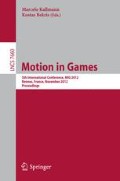Abstract
Speech disorders are common in children and adults. For a number of these individuals, traditional speech therapy will not be successful, leaving them unable to (or poorly able) to communicate through speech. By combining recent advances in motion tracking technology with state of the art interactive gaming technology, we aim to develop a novel clinical tool that can potentially overcome the shortcomings of traditional methods. There is strong evidence that entertaining and clever visualizations not only can provide necessary augmented feedback to facilitate motor skill acquisition but, also, can be very engaging and effective teaching tools. For the first time, we want to explore the practically infinite possibilities for interactive visualizations of game engines in speech rehabilitation focused on the tongue, the primary articulator, and develop a commercial grade clinical rehabilitation tool with full security, reporting, and data management abilities.
Access this chapter
Tax calculation will be finalised at checkout
Purchases are for personal use only
Preview
Unable to display preview. Download preview PDF.
References
Engwall, O., Bälter, O.: Pronunciation feedback from real and virtual language teachers. Computer Assisted Language Learner 3, 235–262 (2007)
Vicsi, K., Roach, P., Oster, A., Kacic, Z., Barczikay, A., Tantoa, A., Csatari, F., Bakcsi, Z., Sfakianaki, A.: A multilingual teaching and training system for children with speech disorders. International Journal of Speech Technology 3, 289–300 (2000)
Piper, A., O’Brien, E., Morris, M., Winograd, T.: Sides: a cooperative tabletop computer game for social skills development. In: Proceedings of the 2006 20th Anniversary Conference on Computer Supported Cooperative Work, CSCW 2006, pp. 1–10. ACM, New York (2006)
Berry, J.: Accuracy of the NDI wave speech research system. Speech Language, and Hearing Research 54, 1295–1301 (2011)
Massaro, D., Bigler, S., Chen, T., Perlman, M., Ouni, S.: Pronunciation training: the role of eye and ear. In: Proceedings of Interspeech 2008, pp. 2623–2626 (2008)
Kuhl, P.K., Meltzoff, A.N.: The bimodal perception of speech in infancy. Science 218, 1138–1141 (1982)
Lucero, J., Maciel, S., Johns, D., Munhall, K.: Empirical modeling of human face kinematics during speech using motion clustering. The Journal of the Acoustical Society of America (January 2005)
Mcgurck, H., Macdonald, J.W.: Hearing lips and seeing voices. Nature 264(246-248) (1976)
Davis, S.M., Drichta, C.E.: Biofeedback theory and application in allied health: speech pathology. Biofeedback Self Regul. 5(2), 159–174 (1980)
Maryn, Y., De Bodt, M., Van Cauwenberge, P.: Effects of biofeedback in phonatory disorders and phonatory performance: a systematic literature review. Appl. Psychophysiol. Biofeedback 31(1), 65–83 (2006)
Mandel, A., Nymark, J., Balmer, S., Grinnell, D., O’Riain, M.: Electromyographic versus rhythmic positional biofeedback in computerized gait retraining with stroke patients. Arch. Phys. Med. Rehabil. 71(9), 649–654 (1990)
Moreland, J., Thomson, M.A.: Efficacy of electromyographic biofeedback compared with conventional physical therapy for upper-extremity function in patients following stroke: a research overview and meta-analysis. Phys. Ther. 74(6), 534–543 (1994); discussion 544–547
Beacutedard, P., Proteau, L.: On-line vs. off-line utilization of peripheral visual afferent information to ensure spatial accuracy of goal-directed movements. Exp. Brain Res. 158(1), 75–85 (2004)
Franklin, D.W., So, U., Burdet, E., Kawato, M.: Visual feedback is not necessary for the learning of novel dynamics. PLoS ONE 2(12), e1336 (2007)
McNeil, M., Katz, W., Fossett, T., Garst, D., Szuminsky, N., Carter, G., Lim, K.: Effects of on-line augmented kinematic and perceptual feedback on treatment of speech movement in apraxia of speech. Folia Phoniatr. Logop. 62, 127–133 (2010)
Hardcastle, W., Gibbon, F., Jones, W.: Visual display of tongue palate contact: electropalatography in the assessment and remediation of speech disorders. Br. J. Disord. Commun. 26, 41–74 (1991)
Engwall, O.: Analysis of and feedback on phonetic features in pronunciation training with a virtual teacher. Computer Assisted Language Learning 25(1), 37–64 (2012), QC 20120416
Dourish, P.: Where the action is: the foundations of embodied interaction. MIT Press, Cambridge (2001)
Ludlow, C.L., Hoit, J., Kent, R., Ramig, L.O., Shrivastav, R., Strand, E., Yorkston, K., Sapienza, C.M.: Translating principles of neural plasticity into research on speech motor control recovery and rehabilitation. J. Speech Lang. Hear. Res. 51(1), 240–258 (2008)
Yunusova, Y., Green, J., Mefferd, A.: Accuracy assessment for AG500, electromagnetic articulograph. Speech Language, and Hearing Research 52, 547–555 (2009)
Yunusova, Y., Baljko, M., Pintilie, G., Rudy, K., Faloutsos, P., Daskalogiannakis, J.: Acquisition of the 3d surface of the palate by in-vivo digitization. Speech Communication 54, 923–931 (2012)
Unity Inc.: Unity3D, http://unity3d.com/unity/
Author information
Authors and Affiliations
Editor information
Editors and Affiliations
Rights and permissions
Copyright information
© 2012 Springer-Verlag Berlin Heidelberg
About this paper
Cite this paper
Shtern, M., Haworth, M.B., Yunusova, Y., Baljko, M., Faloutsos, P. (2012). A Game System for Speech Rehabilitation. In: Kallmann, M., Bekris, K. (eds) Motion in Games. MIG 2012. Lecture Notes in Computer Science, vol 7660. Springer, Berlin, Heidelberg. https://doi.org/10.1007/978-3-642-34710-8_5
Download citation
DOI: https://doi.org/10.1007/978-3-642-34710-8_5
Publisher Name: Springer, Berlin, Heidelberg
Print ISBN: 978-3-642-34709-2
Online ISBN: 978-3-642-34710-8
eBook Packages: Computer ScienceComputer Science (R0)

